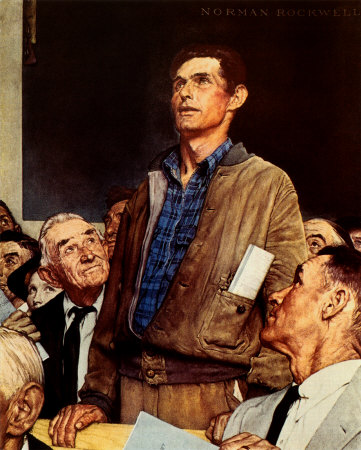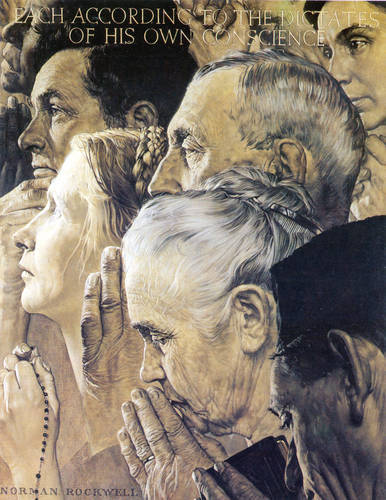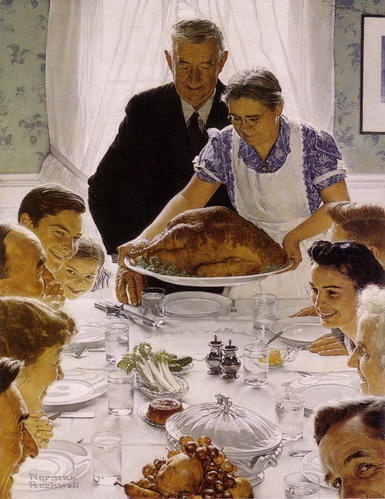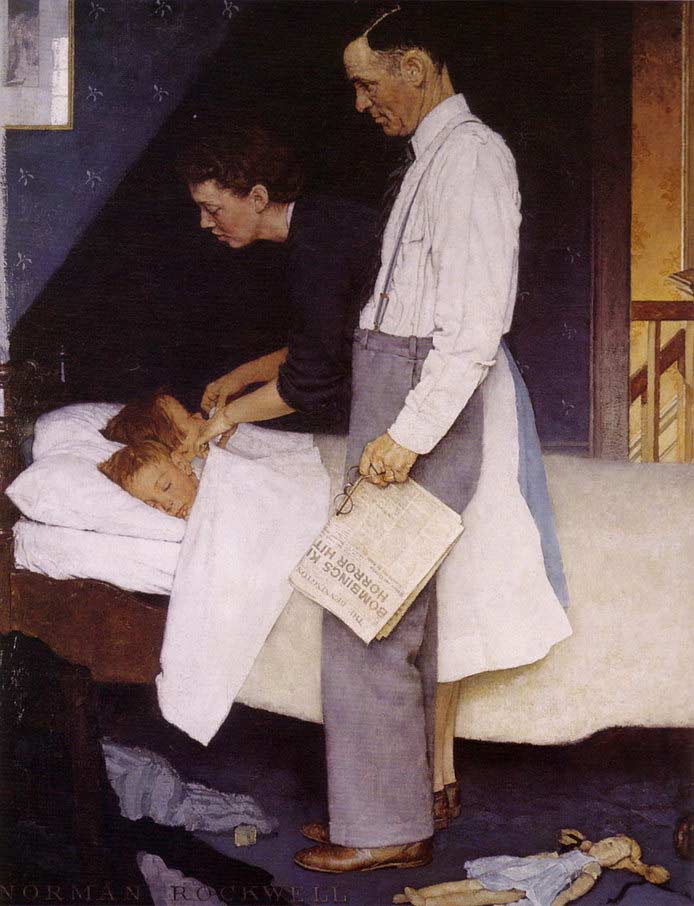Norman ROCKWELL (1894 - 1978)
Norman Rockwell was an American painter and illustrator whose works presented a sentimental idealized view of everyday life.
Norman Rockwell was born in New York City on February 3, 1894. At the age of 14, he enrolled in art classes at The New York School of Art. Two years later, in 1910, he left high school to study art at The National Academy of Design. He soon transferred to The Art Students League, where his discipline, hard work, and sense of humor were widely recognized.
Rockwell found success early. He painted his first commission, which consisted of four Christmas cards, before his sixteenth birthday. While still in his teens, he was hired as art director of Boys’ Life, the official publication of the Boy Scouts of America, and began a successful freelance career illustrating a variety of young people’s publications.
Rockwell's family moved to New Rochelle, New York when Norman was 21 years old and shared a studio with the cartoonist Clyde Forsythe, who worked for The Saturday Evening Post. With Forsythe's help, he submitted his first successful cover painting to the Post in 1916, Mother's Day Off (published on May 20).
In 1943, during the Second World War, Rockwell painted the Four Freedoms series, which was completed in seven months. The series was inspired by a speech by Franklin D. Roosevelt, in which he described four principles for universal rights: Freedom from Want, Freedom of Speech, Freedom of Worship, and Freedom from Fear. The paintings were published in 1943 by The Saturday Evening Post. The originals were then used by the United States Treasury in a 16 city tour seen by 1,222,000 people who purchased over $133,000,000 in war bonds.
Rockwell
married his first wife, Irene O'Connor, in 1916. However, the couple
divorced in 1930. The following year he married schoolteacher Mary
Barstow, with whom he had three children. In 1959, Mary Barstow
Rockwell died unexpectedly of a heart attack. In 1961, Rockwell married
Molly Punderson, a retired teacher.
In his later years, Rockwell began receiving more attention as a painter when he chose more serious subjects such as the series on racism for Look magazine.
Christopher Finch, author and art curator, wrote this about Norman Rockwell: "He is an American original who left his mark not by effecting radical change but rather by giving old subjects his own, inimitable inflection."
From 1953 until his death in 1978, Norman lived at Stockbridge, Massachusetts, where there is a museum devoted to him. In 2008, Rockwell was named the official state artist of the Commonwealth of Massachusetts, thanks to a dedicated effort from students in Berkshire County, where Rockwell lived for the last 25 years of his life.
Adapted from the following sources:
http://www.lucidcafe.com/library/96feb/rockwell.html
http://www.nrm.org/about-2/about-norman-rockwell/
http://en.wikipedia.org/wiki/Norman_Rockwell
Norman Rockwell was born in New York City on February 3, 1894. At the age of 14, he enrolled in art classes at The New York School of Art. Two years later, in 1910, he left high school to study art at The National Academy of Design. He soon transferred to The Art Students League, where his discipline, hard work, and sense of humor were widely recognized.
Rockwell found success early. He painted his first commission, which consisted of four Christmas cards, before his sixteenth birthday. While still in his teens, he was hired as art director of Boys’ Life, the official publication of the Boy Scouts of America, and began a successful freelance career illustrating a variety of young people’s publications.
Rockwell's family moved to New Rochelle, New York when Norman was 21 years old and shared a studio with the cartoonist Clyde Forsythe, who worked for The Saturday Evening Post. With Forsythe's help, he submitted his first successful cover painting to the Post in 1916, Mother's Day Off (published on May 20).
In 1943, during the Second World War, Rockwell painted the Four Freedoms series, which was completed in seven months. The series was inspired by a speech by Franklin D. Roosevelt, in which he described four principles for universal rights: Freedom from Want, Freedom of Speech, Freedom of Worship, and Freedom from Fear. The paintings were published in 1943 by The Saturday Evening Post. The originals were then used by the United States Treasury in a 16 city tour seen by 1,222,000 people who purchased over $133,000,000 in war bonds.
 Freedom of Speech |  Freedom of Worship |  Freedom from Want |  Freedom from Fear |
In his later years, Rockwell began receiving more attention as a painter when he chose more serious subjects such as the series on racism for Look magazine.
Christopher Finch, author and art curator, wrote this about Norman Rockwell: "He is an American original who left his mark not by effecting radical change but rather by giving old subjects his own, inimitable inflection."
From 1953 until his death in 1978, Norman lived at Stockbridge, Massachusetts, where there is a museum devoted to him. In 2008, Rockwell was named the official state artist of the Commonwealth of Massachusetts, thanks to a dedicated effort from students in Berkshire County, where Rockwell lived for the last 25 years of his life.
Adapted from the following sources:
http://www.lucidcafe.com/library/96feb/rockwell.html
http://www.nrm.org/about-2/about-norman-rockwell/
http://en.wikipedia.org/wiki/Norman_Rockwell